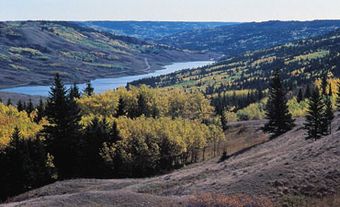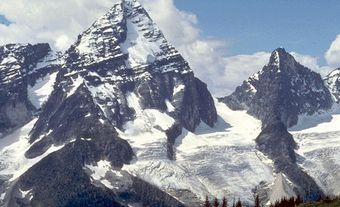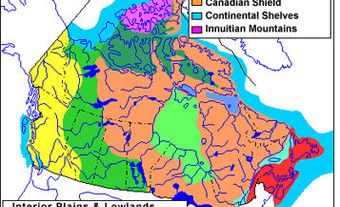Québec's Postglacial Seas
Between about 100 000 and 12 000 years ago, the whole area of Québec as well as a major part of the northern hemisphere was covered with a thick layer of ice. In the late PLEISTOCENE era, just over 12 000 years ago, Québec underwent a gradual warming of the atmosphere. Its territory was then covered by a glacier, the Laurentide Ice Sheet, which was more than two kilometres thick in some places. The compressive force applied by this huge mass pushed the earth’s surface in such a way that the depressions in the landscape ended up below sea level at the time. The lowest regions of Québec were around the great bays (Hudson and James) and in the area along the geological Logan’s Fault, the present day Saint Lawrence River. These troughs remained invisible under the ice cover until the entire area was freed.
At that time, several factors influenced heat distribution in the Québec region, but the atmosphere warmed up mainly from the equator toward the poles (from south the north in Québec’s hemisphere) and from the oceans (or major bodies of water) toward the interior of the continent. The southern area of the Saint Lawrence River, located below mean sea level, was the first to be released from the ice sheet. Then there was an influx of salt water through this new channel from the ocean toward the interior of the North American continent. The Champlain Sea was formed in this way about 12 000 years ago in the Saint-Lawrence Lowlands. The ice sheet slowly continued its retreat north to form the Laflamme Sea in the Saguenay-Lac-Saint-Jean region and the Goldthwait Sea at the mouth of the river, both nearly 2 000 years after the appearance of the Champlain Sea. About 7 000 years ago all the northern perimeters of present day Québec were free of ice, and it was only then that the Tyrrell Sea along the edges of Hudson Bay and James Bay, and the Iberville Sea, in Ungava Bay appeared.
Compared to the map of modern day Québec, these seas in fact represent only an extension (or much larger aquatic geographic area) of the bodies of water near which they are located. For example, the Champlain Sea was nearly 250 kilometres wide at the level of the island of Montréal, and completely covered the lowland areas. In fact, the clay soil found there which is very rich in minerals and nutrients and excellent for farming, is linked to the presence of this former body of water. The Tyrrell Sea in some places penetrated more than 300 kilometres inland into parts of Northern Québec, while the Laflamme Sea made up a little more than double the area of Lac Saint-Jean.
The sea advancing inland in this way brought salt water that mixed with fresh water from the glacial thaw. Part of this fresh water also came from the runoff of precipitation that fed the flow of secondary waters (rivers and streams) which at the time then flowed into the seas. This mix resulted in brackish water with a degree of salinity that gradually increased as it approached the oceans.
Through the years, the Québec territory was freed from the weight of the glaciers and underwent a vertical decompression known as the phenomenon of “isostatic rebound”. Still active today, this vertical movement of the earth’s surface drained the postglacial seas, making their floors reach below mean sea level. During this upheaval, following an inflow of fresh water which was proportionally greater than the salt water, the postglacial seas became progressively desalinated.
The isostatic upheaval took place in more or less gradual steps. Today we can observe the progression of the level of these seas in various ways. For example, on the island of Montréal, there are a series of marine terraces around Mont-Royal that represent various regressive episodes of the Champlain Sea. These rounded landscapes, smoothed by the action of the water, are today marked by the network of walking trails in the park. Further, as a result of archeological excavations, fossils and the remains of marine organisms typical of the saline environment were found there.
In the lower North Shore previously occupied by the Goldthwait Sea, sites previously occupied by Amerindians were discovered some distance from the present day Saint-Lawrence. The remains show that there was a village located alongside the river with a water level more than 5 metres higher than that observed today. For each area once covered by postglacial seas, maps of the surface deposits represent traces of seas and lakes.

 Share on Facebook
Share on Facebook Share on X
Share on X Share by Email
Share by Email Share on Google Classroom
Share on Google Classroom


